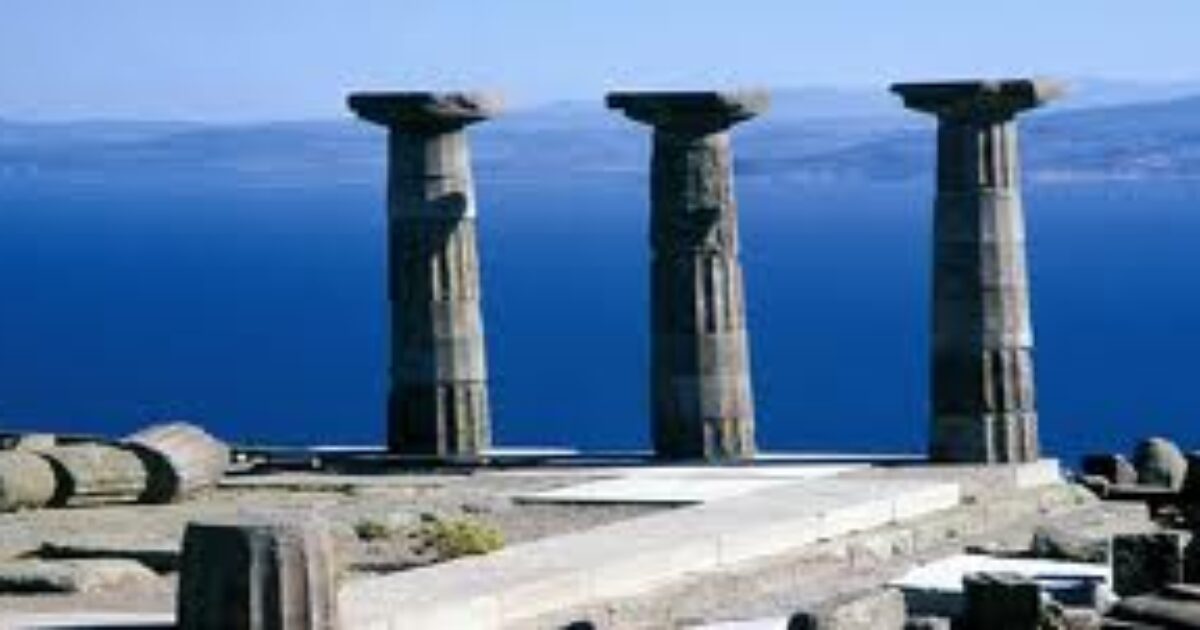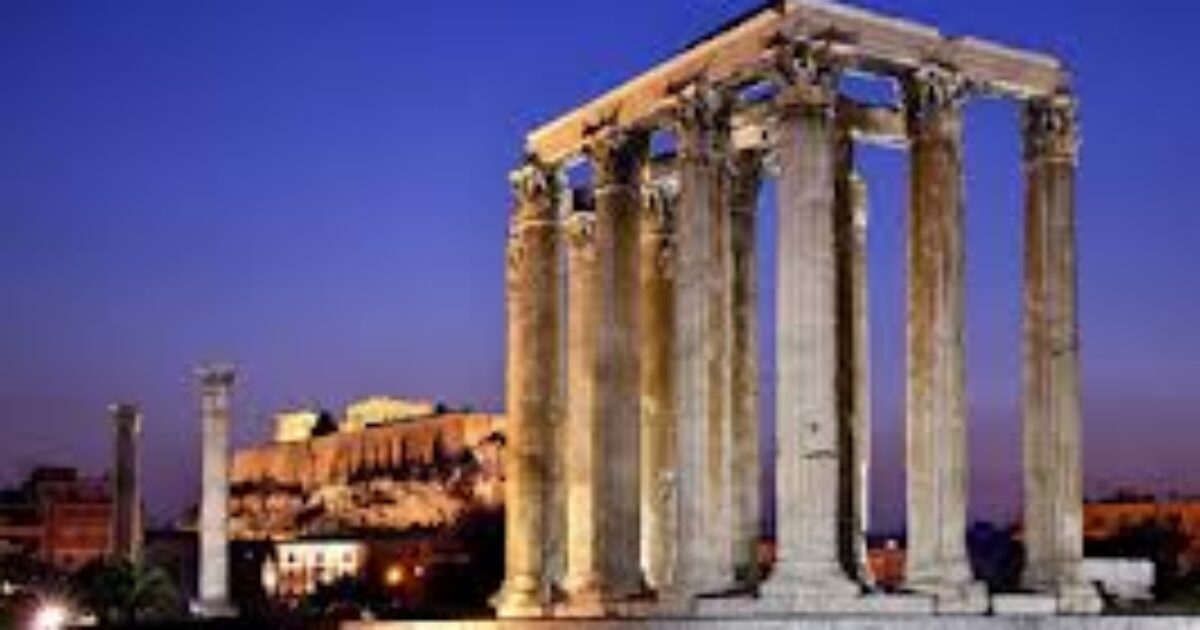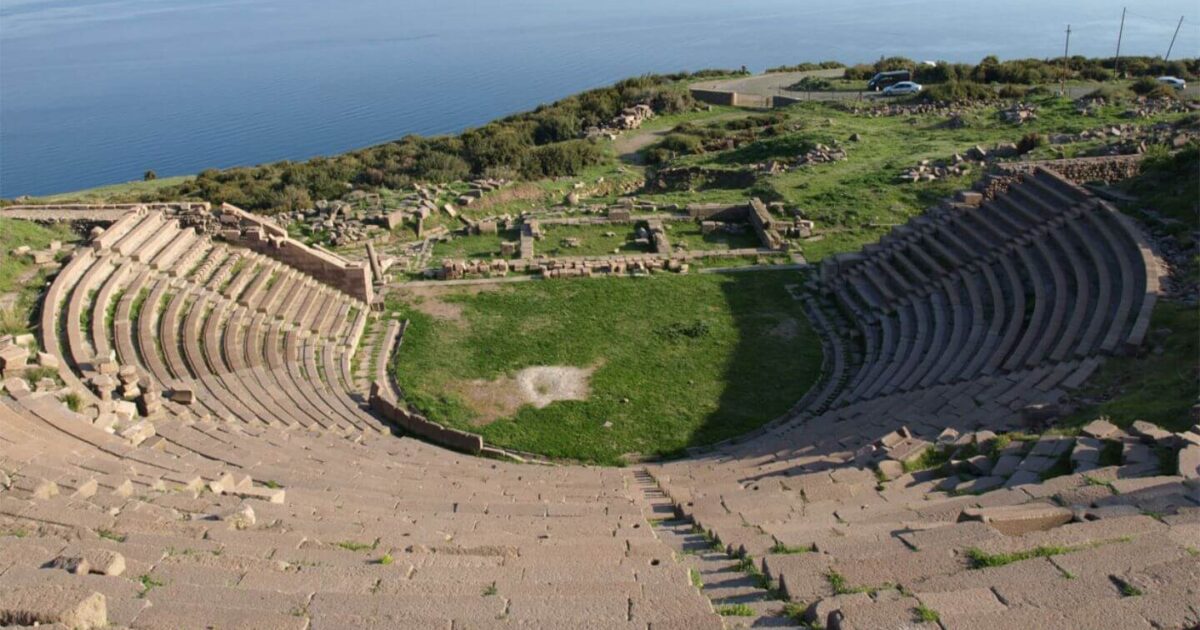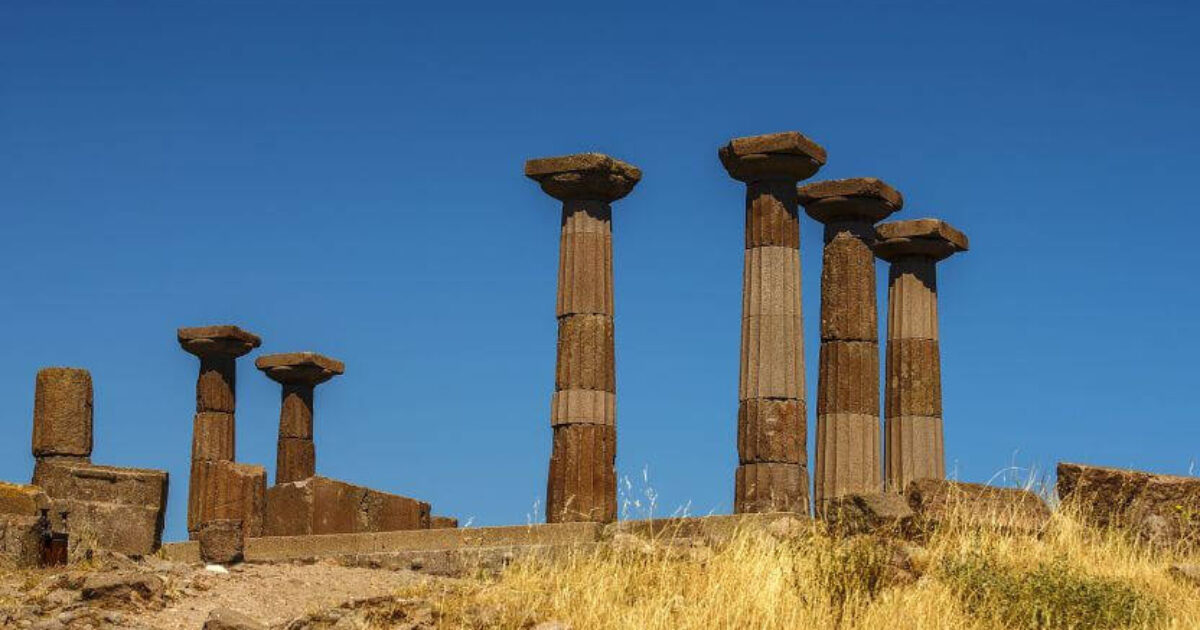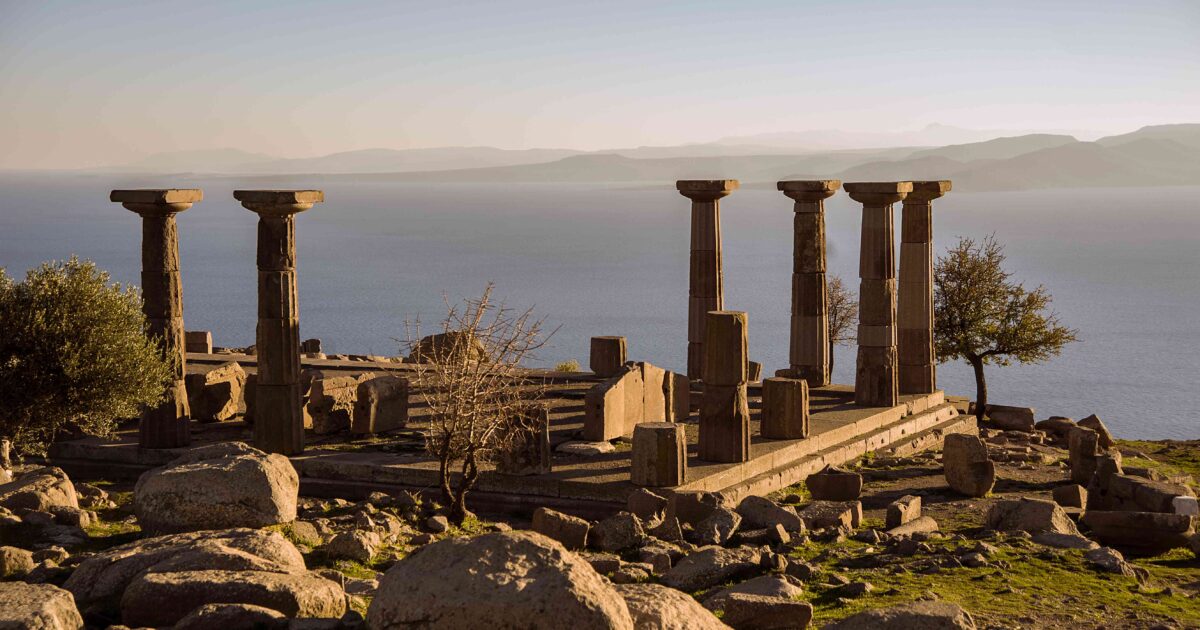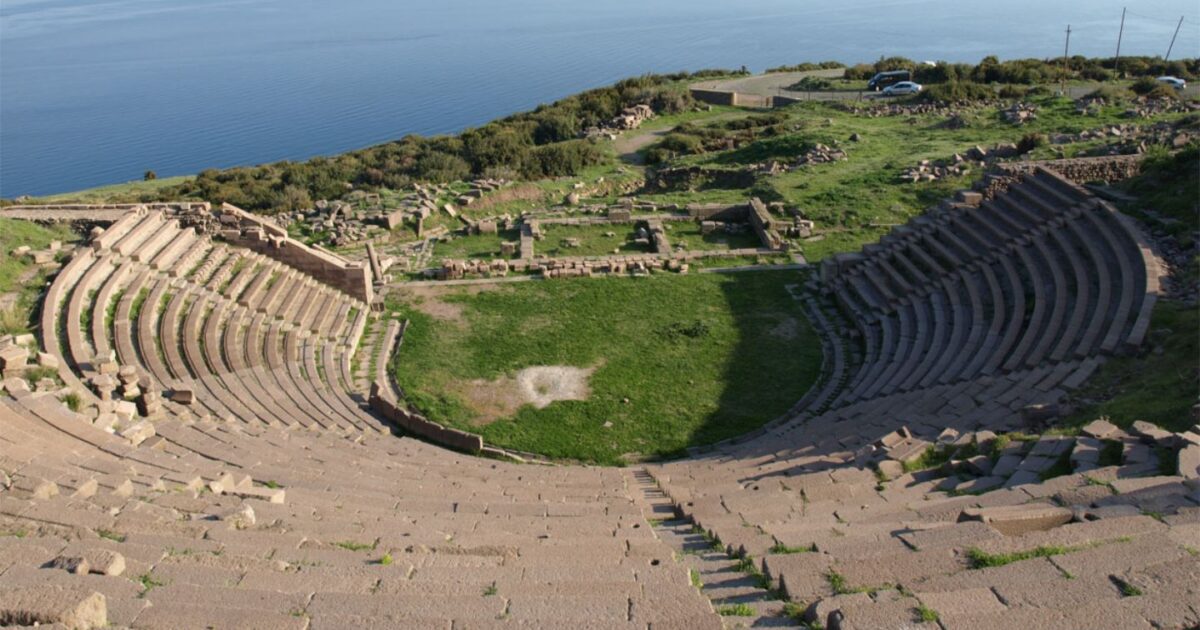Assos, also known as Behramkale or for short Behram, is a small historically rich town in the Ayvacık district of the Canakkale Province, Turkey.
After leaving the Platonic Academy in Athens, Aristotle (joined by Xenocrates) went to Assos, where he was welcomed by King Hermias, and opened an Academy in this city. Aristotle also married Pythias, the adopted daughter of Hermias. In the Academy of Assos, Aristotle became a chief to a group of philosophers, and together with them, he made innovative observations on zoology and biology. When the Persians attacked Assos, King Hermias was caught and put to death.Aristotle fled to Macedonia, which was ruled by his friend King Philip II of Macedon. There, he tutored Philip's son, Alexander the Great. There is a modern statue of Aristotle at the town entrance.
Assos was also visited by St. Paul. Today, Assos is an Aegean-coast seaside retreat amid ancient ruins.
Assos Geographical Location:
Though officially named Behramkale (pronounced [behˈramkale]), most people still call the town by its ancient name of Assos. The town is on the southern side of Biga Peninsula, better known by its ancient name, Troad. The town is located on the coast of the Adramyttian Gulf (Turkish: Edremit Körfezi).
It is possible to see much of the surrounding area from the ancient Temple of Athena, built on top of a trachyte crag. From this temple, it is possible on a clear day to see nearby Lesbos in the south, Pergamum in the southeast, and Mount Ida of Phrygia in the east. To the north, the Tuzla River flows. To the northwest, there is the gate to the city of two massive Hellenic columns that still exist today.
Assos had a harbour, which was the only good harbour on the 80 kilometres (50 mi) of the north coast of the Adramyttian Gulf. This made Assos a key shipping station through the Troad.
Assos Physical Location:
Assos is situated 87 km south of Canakkale on a volcanic headland with magnificent views over the Aegean and island of Lesbos. Six columns from the partially-restored Temple of Athena now stand on the hilltop.
History of Assos:
The city was founded from 1000-900 BC by Aeolian colonists from Lesbos, who specifically are said to have come from Methymna. The settlers built a Doric Temple to Athena on top of the crag in 530 BC.[not in citation given]
From this temple Hermias of Atarneus, a student of Plato, ruled Assos, the Troad and Lesbos for a period of time, under which the city experienced its greatest prosperity. (Strangely, Hermias was actually the slave of the ruler of Atarneus. Under his rule, he encouraged philosophers to move to the city. As part of this, in 348 BC Aristotle came here and married King Hermeias's niece, Pythia, before leaving for Lesbos three years later in 345 BC. This 'golden period' of Assos ended several years later when the Persians arrived, and subsequently tortured Hermias to death.
The Persians were driven out by Alexander the Great in 334 BC. Between 241 and 133 BC, the city was ruled by the Kings of Pergamon. However, in 133 BC, the Pergamons lost control of the city as it was absorbed by the Roman empire.
St. Paul also visited the city during his third missionary journey through Asia Minor, which was between 53-57 AD, on his way to Lesbos. From this period onwards, Assos shrunk to a small village, as it has remained ever since. Ruins around Assos continue to be excavated.
The pillars from the ancient port lay in the harbor for over a millennia. Eventually they were probably sold.
In the early 1900s an attempt was made to move the contents of the Temple of Athena. Much of the art has been moved to museums like the Louvre. The art found includes pictures both of mythical creatures and heraldic events.
Many of the old buildings of Assos are in ruins today, but Behramkale (the city's modern name) is still active. It still serves as a port for Troad. On the acropolis 238 m above sea level are the remains of the Doric order Temple of Athena, which date back to 530 BC. Six of the original 38 columns remain. West of the acropolis stands the well preserved 4th century BC city wall and main gate with 14 meter high towers. An ancient paved road leads Northeast through the gate to ruins of a large 2nd century BC gymnasium, a 2nd century BC agora and an bouleuterion. Further south toward the ocean is a 3rd century BC theatre built for 5,000 spectators.
Down the steep seaward side of the hill at the water's edge is the hamlet called Iskele (meaning Dock or Wharf), with old stone houses now serving as inns, pensions and restaurants.
There is a small pebbly beach. There are boat tours and tours of the hamlet itself. Although the narrow road to the hamlet is steep with sheer drops, the sea front has a constant stream of cars and minibuses arriving from dawn to dusk.
Archaeological Excavations in Assos:
Beginning in 1881, the Archaeological Institute of America sponsored investigations at Assos, a classical site on the Aegean coast of Turkey some 30 miles south of Troy. With its ruined sixth-century B.C. temple atop a rocky promontory overlooking the sea, extensive fortification walls, a large cemetery, and Roman theater, Assos was a promising site. The excavations lasted for only three seasons, investigating and documenting the Temple of Athena, a gymnasium, the agora (with a two-story stoa on one side), the theater, the bouleuterion (council house), and elaborate tombs. Afterward, the finds from the site were divided, as was customary at the time. Sculptures from the Temple of Athena were dispersed, most going to the archaeology museum in Istanbul, but some going to the AIA (and hence into the Museum of Fines Arts, Boston). A few removed earlier are in the Louvre. Today, the Aegean University in Turkey is working at the Assos, conducting some excavations and working on restoration of the Temple of Athena, the theater, and other structures.
Philosophy in Assos:
Assos is the city where the great philosopher Aristotle taught philosophy and wrote some of his books. At the same time the home town of the Stoic philosopher Cleanthes, it is located on the Turkish coast of the Aegean Sea, south to the ancient city Troy, east to the Greek island of Lesbos. Its importance in the history of philosophy as well as for its natural beauty and unspoiled authenthic Aegean culture.
The Assos King Hermias had a sister of legendary beauty by the name of Pythias. Whoever set eyes on her could never get her out of his mind. The philosopher Aristotle was an old school friend of Hermias, who invited him to Assos. Accepting the invitation, Aristotle saw Pythias at dinner and fell in love with her at first sight, to the point that he could no longer eat or drink. Realizing the situation, Hermias promised Aristotle he would give him his sister if Aristotle would open a school at Assos. Naturally the story has a happy ending. Aristotle married Pythias and in the meantime founded his famous school of philosophy. It was here that he composed his famous work, In Praise of Virtue, between the years 348 and 345 B.C.
What to visit places in Assos:
North Section & Bridge
Driving to Assos from the modern city of Cannakale to the north, passing by Troy en route, you cross the Tuzla stream on a modern bridge that runs parallel to the old Ottoman one. On the far side, the road begins to ascend toward Behramkale and Assos. The acropolis of Assos, reaching 238 meters above sea level, is still protected by towers and walls and crowned by the ruins of a sixth-century B.C. temple to the goddess Athena.
The Village of Behramkale
The old village grew on the north slope of Assos, out of sight from the sea, possibly because of concerns about piracy prevalent in the middle ages. Houses throughout the village differ according to the date they were built, creating an architectural mosaic. Behramkale has gained a bohemian reputation from its local arts and crafts community.
Acropolis & Temple of Athena
Atop the acropolis is the temple of Athena, which was built around 530 B.C. The temple is unusual because some elements are of Doric style (the columns), but its decorative frieze is characteristic of the Ionic order. The reliefs from the frieze, which depict centaurs, animals, and human figures are in museums in Istanbul, Çanakkale, Paris, and Boston. Capitals and columns scattered around the site and are in a fairly good state, and enough exist to re-create a corner of the temple. Beginning in 2008, Turkish archaeologists, supported by the AIA, will dismantle the standing columns set-up in the 1980s using modern concrete replacements
Assos' spectacular layout is apparent from the acropolis, and the view in every direction is stunning. On the east, traces of ancient walls appear above dense shrubs and trees. To the north are the red-tiled roofs of the houses of Behramkale. West and south, the ancient ruins are exposed on a series of terraces below the acropolis. In the distance is the Aegean and the island of Lesbos.
Northwest Wall & Polygonal Wall
Continuing the exploration of Assos, descend back through Behramkale and head toward the west gate. The modern road passes a prominent section of the fourth-century wall with several square towers. The wall is discontinuous here, but farther along, toward the west, one section incorporates part of an earlier, sixth-century B.C. wall, the polygonal masonry of which stands out in contrast to the rectangular blocks of the later one. Remains of this early polygonal wall have been documented throughout the site. Different masonry types can be used to identify different periods and show how structures are re-used throughout the centuries. More recent recycling is seen in the removal of ancient stone blocks to build houses in Behramkale during the nineteenth and early twentieth centuries.
The Western Necropolis & the Tomb of Publius Varius
The main street on the west side of Assos was lined by burials, and because of this was given the name "Street of Tombs" by the American excavators. Visitors today can walk along its length to the Western gate, through which you'd enter the city in antiquity. Family burial precincts are marked by clusters of andesite sarcophagi. In addition there are a few burials in large ceramic jars or pithoi. Immediately to the left of the gate is the monumental tomb of Publius Varius.
West Wall & Gate
Built around the fourth century B.C., the city's strong fortification walls are among its most impressive remains. In the western section, the great walls can be seen clearly from both the acropolis and as you walk up the Street of Tombs. The west gate is a magnificent sight, with the left tower still standing more than 14 m.
Behind the West Gate: Civic Center
After entering the west gate, the street passes through the civic center of ancient Assos, which was set on a broad terrace below the acropolis and above the theater. Immediately to the left of the west gate was the gymnasium, where the upper class youths exercised and were taught. Little remains here from a second-century B.C. gymnasium that was possibly an alteration of an older gym where Aristotle once taught. Beyond the gymnasium was a shrine commemorating an unknown hero, the marketplace or agora, and the council house or bouleuterion, dated to the second and third century B.C. The agora at Assos was demarcated by stoas--long, colonnaded buildings that would have held shops and offices--on its north and south sides. To the east, are the foundations of the bouleuterion. The view from the agora of the Aegean and the island of Lesbos is stunning. Below, one sees the theater, which also reaps the benefit of this magnificent vista.
Theater
The theater of Assos has a spectacular view of the Aegean and Lesbos. Directly below the south stoa of the agora and perched above the harbor, it could hold some 5,000 spectators. Well-preserved in part, sections of the theater have been reconstructed with concrete blocks.
The Harbor
During their excavations in the 1880s, the American crew stayed at the harbor. Francis Bacon wrote of the camels bringing loads of acorns (used for dye) and of making the long hike up to the acropolis several times each day. The harbor today has several small guesthouses and restaurants.
Eastern Section
Although little of the eastern section of Assos has been excavated, remains of the eastern wall and necropolis as well as ancient streets can be seen.
Guide - Çanakkale
- Canakkale Turkey Travel Guide
- Things to do in Canakkale
- Places to Visit in Canakkale
- Places to Visit around Canakkale
- Gallipoli Travel Guide
- The Temple of Apollon Travel Guide
- Gallipoli Peninsula National Park
- Bozcaada Travel Guide
- Gokceada Travel Guide
- Mount IDA
- Assos Travel Guide
- Troia Travel Guide
- Alexandria Troas Travel Guide
- Cimenlik Castle
- Kilitbahir Fortress
- Map & Direction
- Transportation to Canakkale by Bus
- Transportation to Canakkale by Flight
- Transportation to Canakkale by Car
- Transportation to Canakkale by Ferry
- Transportation to Canakkale by Fast Ferry
- Transportation to Bozcada
- Transportation to Gokcecada
- Canakkale Hotels
- Gallipoli Hotels
- Troy Hotels
- Gelibolu Mevlevihanesi
- Troy Tours
- Troy Tours
- Camping
